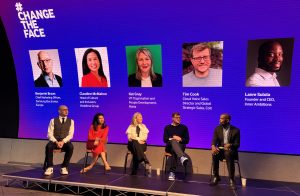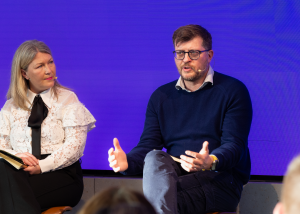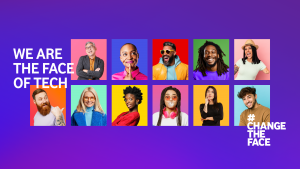
New industry research on neurodiversity in the tech sector was launched at the #ChangeTheFace Embracing Neurodiversity in the Workplace event this week.
Colt’s own Tim Cook, Cloud Voice Sales Director, joined a panel alongside Vodafone, Nokia and Samsung to discuss the research and share his own story of someone diagnosed as neurodivergent later on in life.
Commissioned by the #ChangeTheFace Alliance, the research ‘Neurodiversity in the Tech Sector’ is the largest global workplace study of its kind to date. It presents findings from a literature review, neurodivergent employee focus groups and a survey of over 2,000 responses.
The study revealed that nearly half of neurodivergent employees feel impacted by their conditions in the workplace, with a quarter disclosing that they were impacted every day. It is estimated that 15-20% of the global population are neurodivergent.
The study exposed four key findings:
- Organisations must foster trust and proactively explore support options, making the workplace more accessible for neurodivergent individuals
- Organisations need to evaluate their culture’s impact, making adjustments to support neurodivergent employees effectively
- Support should be accessible without a formal diagnosis or disclosure, promoting inclusivity and understanding
- Organisations must invest in training to foster a culture of allyship and understanding
Advice from the panel
During the event, the panel shared their experiences, expertise and advise on the topic of neurodiversity in the workplace which we have collated into four areas:
1. Inclusion should be leader-led
Neurodiverse leaders should lead inclusion efforts by sharing their own experiences to normalise diversity. They must know how to create a psychologically safe workplace where individuals feel comfortable sharing. Training and awareness programmes are essential to support this culture of openness.
“At Vodafone, we have training for employees, managers and for recruiters. One thing that stuck with me was when a trainer said ‘it’s not people who are disabled, it’s the environment that is disabling.’ It’s not just about the physical working environment but about all of our behaviours and how we come together to normalise sharing whatever we want to share,” said panellist Claudine McMahon, Head of Culture and Inclusion at Vodafone.
2. Set up an accessibility network and build a system of allies
Employee networks are critical because they are essentially a group of activists. Leaders in an ERG can help challenge the system on behalf of the members and also ensure the group is supported by the ELT. At Colt, our Disability Accessibility Network (DAN) was set up by Tim Cook, who added:
“Since that point (setting up DAN), we’ve worked hard to be included in other parts of the business, drawing together to talk about neurodiversity, disability and accessibility within offices and from home. For instance, our building in India is very accessible because we were involved in that process. We weren’t an afterthought, we made sure we were embedded in from the beginning.”
On the topic of allyship, panellist Kat Gray, VP Organisation and People Development at Nokia said: “The challenge that we’ve got is culture and culture doesn’t change overnight. And so it’s about beliefs, behaviour and education. By having a sense of allyship, it prevents the burden of always being on the minority. There’s always this barrier of awareness and a fear of saying the wrong thing. It’s really important to then build this ecosystem of allies and educate those folks who can really embed it into the fabric of your organisation.”
3. Start with the ‘quick wins’
Implement measures such as creating quiet workspaces, offering adjustments, scheduling meetings and reviews well in advance, providing considerate feedback, allowing diversity mentions in email signatures, simplifying job descriptions, using social media for education, avoiding isolated comms, and encouraging diversity data sharing.
Claudine commented: “The stat that really sticks with me is that one in five people are neurodiverse. That means we all work with, know or love someone who is neurodiverse. I would love for every single one of us to take the time to learn and then take action. In the workplace, it could be as simple as making sure that people have everything they need to come prepared for a meeting because that causes huge stress for people who are neurodiverse.”
Panellist Benjamin Braun, CMO at Samsung Electronics added: “We’re currently recruiting for a position. I posted the job description on LinkedIn. It is half images and half text. It’s got about 47,000 impressions so far. The next task is to create a presentation, but I’m trying to take us out of the ordinary perspective of a PowerPoint presentation so I’m asking the candidates to create a short video. This way we can see people that are representative of all types of backgrounds.”
4. Take advantage of technology
Tim explained: “I think that organisations really have a technology pivot point happening now. Ten years ago we just had simple tools like Spell checker. Now we have AI-based solutions and Microsoft’s Copilot. The technology is absolutely amazing, not only for neurodivergent people but for everybody. Organisations need to double down on their technology and get it out into the hands of the people who need it. But we must also train them on how to use it because there’s so much ‘good stuff’ in there and people are unaware of how much it could benefit them.”
From the event, it’s clear that together we can pave the way for a more accessible and supportive future but the call to embrace neurodiversity continues. “Much more needs to be done,” said Serpil Timuray, CEO Europe Cluster of Vodafone and event keynote speaker. Businesses have the power to transform such insights into lasting change and create environments where everyone can excel. “This is not an area of competition (for busineses) but an area for collaboration,” Serpil finished.
If you would like to read the full Neurodiversity in the Tech Sector research report, you can do so here. Or learn more about DE&I at Colt.


What's your goal today?
1. Are you on the Colt IQ network?
Our network connects over 31,000 buildings worldwide powering companies such as Hitachi, Atos, Forbes, Arthur D Little, Brussels Airlines and thousands of others. Find out if you're Colt connected now.
2. Learn about digital infrastructure
We've written thousands of guides and white papers, regularly publish content on our blog and host regular events on everything from enterprise network connectivity, to cloud, digital transformation and the hybrid workforce.
3. Join our team
To learn more about joining our team of over 5000 people around the world, and to browse our current open roles visit https://careers.colt.net/.

